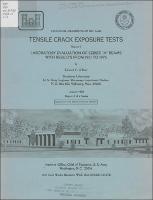Please use this identifier to cite or link to this item:
https://hdl.handle.net/11681/21415Full metadata record
| DC Field | Value | Language |
|---|---|---|
| dc.contributor | Structures Laboratory (U.S.) | - |
| dc.contributor | United States. Army. Office of the Chief of Engineers | - |
| dc.contributor.author | O'Neil, Edward F. | - |
| dc.date.accessioned | 2017-02-15T14:35:52Z | - |
| dc.date.available | 2017-02-15T14:35:52Z | - |
| dc.date.issued | 1980-01 | - |
| dc.identifier.uri | http://hdl.handle.net/11681/21415 | - |
| dc.description | Technical memorandum | - |
| dc.description | Abstract: A study was begun in 1950 to determine the effects of severe natural weathering to stressed, reinforced concrete beams of various compositions and degrees of stress. The objectives of the study were to obtain information on the long-term weathering of air-entrained and nonair-entrained concrete beams containing steels of different compositions, types of deformation, and having different levels of stress in the steel that caused varying degrees of cracking of the concrete. The beams were fabricated, cured, and loaded at the U. S. Army Engineer Waterways Experiment Station (WES) in 1951, then shipped to Eastport, Maine, and placed on the beach at the natural weathering exposure station on the south side of Treat Island, Cobscock Bay, Eastport, and Lubec. The beams were subjected to twice daily tidal cycles exposing them to wetting under considerable head, and drying to surface dry conditions. In addition, during the winter months, the beams were subjected to cycles of freezing and thawing with each tide when the air temperature was at or below 28°F (-2.2°C). The beams were inspected annually during the exposure period and evaluated by a team of inspectors rating the degree of deterioration. Each year, maximum crack widths were measured beginning in 1956 and continuing until 1975 when the exposure period was concluded after 25 years of weathering. At the end of the exposure period, 13 of the 82 beams still remained at the testing site; 60 of the beams had been destroyed by freezing and thawing by 1956, since they were nonair-entrained concrete. Of the 13 beams remaining in 1975, 11 were returned to the laboratory for laboratory testing. The results of the exposure study and the laboratory investigation indicated, among other findings, that stressing the steel to varying levels of stress over the exposure period did not reduce the ultimate moment carrying capacity of the beams; the maximum areas of corrosion occurred at spalled areas; corrosion to the steel could not be located at any flexural crack smaller than 0.015 in. (0.38 mm); and no area of maximum reduction of crosssectional area due to corrosion occurred at the flexural cracks. | - |
| dc.publisher | U.S. Army Engineer Waterways Experiment Station. | - |
| dc.publisher | Engineer Research and Development Center (U.S.) | - |
| dc.relation | http://acwc.sdp.sirsi.net/client/en_US/search/asset/1049330 | - |
| dc.rights | Approved for public release; distribution is unlimited. | - |
| dc.source | This Digital Resource was created from scans of the Print Resource. | - |
| dc.subject | Air entrained concretes | - |
| dc.subject | Concrete beams | - |
| dc.subject | Concrete cracking | - |
| dc.subject | Concrete exposure | - |
| dc.subject | Freeze-thaw durability | - |
| dc.subject | Reinforced concrete | - |
| dc.subject | Tensile strength (Concrete) | - |
| dc.subject | Weathering (Concrete) | - |
| dc.title | Tensile crack exposure tests. Report 3, Laboratory evaluation of series "A" beams with results from 1951 to 1975 | - |
| dc.type | Report | en_US |
| Appears in Collections: | Technical Memorandum | |
Files in This Item:
| File | Description | Size | Format | |
|---|---|---|---|---|
| WES-Technical-Memorandum-No.6-412-Report-3.pdf | 3.74 MB | Adobe PDF |  View/Open |